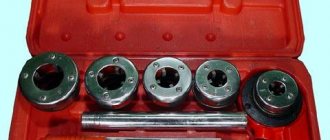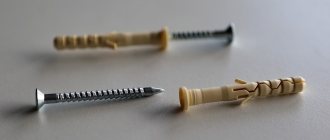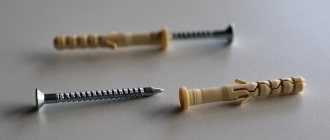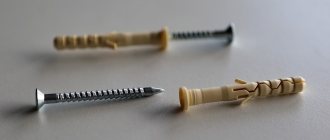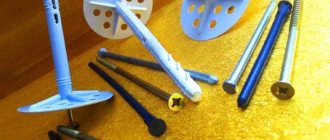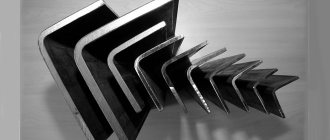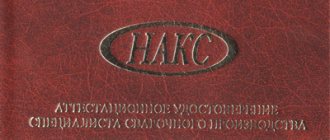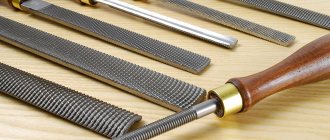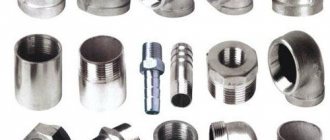A device such as a pipe clamp 1 1 2 or 1.1/4 is a tool that is very relevant in situations where metal pipes are being installed or repaired. In principle, welding is used to create most of the connections of such a pipeline, but, as a rule, the system also contains many elements that are connected to the pipes using threads.
Photo of pipe clamp
Example of threaded elements
But the problem is that the end of the pipes does not always have this same thread. To create it, a manual thread-cutting pipe clamp is usually used.
In short, the principle of operation here is something like this:
- the end of the pipe is inserted into a special cylinder with cutters;
- then this cylinder begins to rotate;
- During rotation, the tool's cutters act on the plane of the metal, thereby making a thread in it.
Well, in more detail, there are a lot of nuances that it is very advisable to know about before purchasing a set of pipe clamps of different diameters. In this article we will look at such points in detail, and also consider how to work with such a device. (See also the article Sewage system: features.)
Let's start with the main point.
Why is this even required?
Despite the fact that the 21st century has arrived relatively long ago, and store shelves are full of various modern materials for gas and water pipes, carving as such is still relevant. It has been used for quite a long time, but still there is no reason to refuse its use.
On a note! Of course, polyethylene pipes are connected to each other using compression fittings, while polypropylene pipes are generally soldered. It is not only easy, but also convenient and fast.
However, all plastics (including composites made on their basis) are characterized by two significant disadvantages.
- Firstly , high temperatures are contraindicated for them. For example, the “ceiling” for polypropylene is only +90 degrees. This is true, you will notice, but in accordance with the standards and requirements, there should not be a higher temperature in the pipelines of residential buildings; That’s right, but in many northern regions, due to cold winters, heating systems have to exceed these standards, otherwise people may simply freeze. And if the temperature in the plumbing/heating system exceeds +100 degrees, that is, the boiling point of water, then polypropylene in this case cannot be used at all. As for PE pipes, the maximum permissible temperature for them is only +40 degrees.
- Secondly , the mechanical strength of plastics/composites is low. And if the pipeline needs to be laid, say, under a popular road or in a restaurant toilet, where it can be damaged by drunken visitors, then the use of plastic must be abandoned altogether! The same applies to metal-plastic pipes, which can easily be deformed or removed from the fitting.
Important information! If you need a heat-resistant pipeline, we recommend paying attention to copper. Pipes made from it can be used at temperatures from 0 (if the temperature is lower, the water will simply turn into ice) to +250 degrees. However, copper is quite expensive, and due to the fact that pipes made from it have thin walls, its strength under lateral loads is unsatisfactory.
What options are left? Unfortunately, only steel. Preference, of course, is better to give galvanized ones, since there is definitely too much rust in the pipeline.
Note also that there are two ways to achieve a tight connection between steel pipes:
- use a threaded connection;
- use welding.
At the same time, not everyone can boast of having a welding machine; in addition, after welding, the protective zinc layer is damaged. And this leads to rusting of the welds. Consequently, such a water supply system will initially have vulnerable spots.
Conclusion
Despite the fact that today plastic sewer pipes are very popular due to their low cost and ease of processing, metal ones remain more practical and reliable. The best connection for them is a threaded one, which in turn is most convenient to cut with a screw. The types and features of such a tool are described above.
Pipe cutting die equipped with an electric drive
The video in this article will introduce you to additional materials. Use the most convenient tools for working with plumbing!
Did you like the article? Subscribe to our Yandex.Zen channel
What can you use for thread cutting?
If we consider the process from the point of view of labor and time costs, then the best option would be not a pipe clamp, but a lathe. You just need to place the pipe in the spindle, then tighten it, cut off the excess using a cutting tool, straighten the edge, and then, after changing the tool, select the parameters of the required thread. Basically, that's all.
Note! Even in the absence of a cutter, such a machine will make it possible to cut threads using hand tools. Moreover, in this case the tool will not overheat, which is also a definite plus.
But not everyone has the opportunity to use a lathe. Therefore, only hand tools remain - the die and the die discussed in today’s article. But besides these tools, you will also need something to cut the pipe. And this can be done either using a pipe cutter, or using a manual turbine or an ordinary hacksaw for metal.
What to look for when choosing
When purchasing an electrical thread-cutting die, you should consider the following points:
- The complete set includes replaceable nozzles – standard or extended. As a rule, the kit includes dies for the most common thread diameters.
- Unit power - both the speed and quality of work depend on the power characteristics of the electric motor.
- Dimensions of the tool - as a rule, the average weight of the electrical socket is in the range of 20-25 kg. But there are also more massive instruments, so you should focus on the ease of carrying and using it.
- The ergonomics of the handle and the device itself - how well the tool fits in the hand, and whether it is possible to use it in hard-to-reach places. You should also pay attention to the possibility of chip removal.
- Material and thread direction of nozzles - it is advisable to have nozzles in the kit designed for both right-handed and left-handed threads. Nozzles made of cheap metal wear out quickly, so you need to choose cutters made of alloy steel.
- Build quality and the name of the manufacturer - from conscientious manufacturers, the tool is well assembled and will not fail during operation.
Klupp - what is it?
So, a clamp is a fairly effective device used in the installation of pipeline systems. In principle, it is a die that is familiar to us (or a “lerk”, as it is also called). The device consists of a small cylindrical part with a recess for removing chips out during thread cutting. In addition, along the entire perimeter of the tool there is also a recess necessary for comfortable clamping with the help of a holder. Inside the tool there are ridges, which, in fact, form the thread.
What is the difference between the described device and the same die? The fact is that in the first case, only the cutters remained from the die as the main functional part of the device. And they are attached directly to the holder, and it, in turn, serves as a guide.
Where and when a tool is needed
A die is a device for cutting metric, persistent, pipe threads on metal products or other hard materials. This is a metal cylinder with a complex body geometry and removable comb-shaped cutters inside, which make slits in the metal. Unlike a collapsible die, the usual die (in everyday life )
is a monolithic tool, so it is used less and less.
The Klupp belongs to professional thread-cutting equipment, but is used in everyday life as often as in production. The popularity of the device is due to its low price, simplicity of design and ease of use in the most inconvenient places.
Advantages of a die over a simple die
Typically the die is made of expensive tool steel. In this case, only the cutters must be especially strong, because they form the thread. And the die, as we noted earlier, is also a die, but without expensive and non-functional elements. An inexpensive holder, as well as durable cutters, is all that is required in this case.
It would seem illogical to consider the tool as a budget alternative to a die: on the market you can find dies whose cost is measured in thousands of dollars. But do not forget that the cutters here are replaceable elements.
What are the savings anyway? On consumables. As for the tool, its cost is so high for the reason that it makes the thread cutting process less tedious and more convenient.
Video - Pipe clamp: what is it?
Key varieties of klupp
We should start with the fact that pipe clamps are divided into several groups depending on ease of use and, of course, price. Let's take a closer look at these groups.
Group No1. Simple hand tools
Let's not beat around the bush - we are talking here about the simplest die in a simple holder. Visually there is no difference at all. The round frame is a guide that has clamps for the cutters and a pair of handles necessary for its rotation.
Group No2. Hand tools with ratchet
This design is a slightly more complicated version of the previous one - the frame is equipped with a ratchet, thanks to which it becomes possible not to intercept the handles. You just need to make reciprocating movements with one handle (like pumping water with a pump).
Important information! If you find both the first and second variants of the clutch in the store, but their cost is the same, then it is certainly better to give preference to the first. After all, a ratchet in tandem with cheap Chinese production (read: the use of low-quality metals) is a very dangerous combination, which you should definitely stay away from.
Group No3. Electrical tools
But in this case, all the work with the device consists of correctly installing the pipe and pressing the appropriate button. The electric drive will handle everything else perfectly. Having a fairly modest power (estimated at only a few hundred watts), such tools are capable of developing great force, which is possible due to the significant transmission coefficient on the gearbox.
Interpretation of the term
Plashka is a Russian word, klupp has German roots. The interpretation of the meaning of “clump” by dictionaries is almost unambiguous - a hand tool consisting of a mandrel with inserted dies. Dictionaries (Encyclopedic, BES and Technical Railway Dictionary) add two (!) handles. Dictionaries are far from real life, and any manager selling hand tools will be able to offer models of pipe clamps for thread cutting with one handle or without handles - with an electric drive.
What is the difference? It's just a difference in purpose. A die (dies) is a cutting part, and a die is a frame, a mandrel for dies (the latter in the plural).
Pipe clamp selection criteria
At the moment, the industrial industry has developed so much that clamps are sold in a huge assortment and in a variety of modifications. Russian markets are replete with a variety of products, including those made in the West, which in most cases are of higher quality. As for specific prices, we will talk about them a little later, we will only note that they, as well as the choice, have a considerable spread. When choosing the tool described in the article for yourself, be sure to consult with a qualified specialist in advance. In any case, it is better not to give preference to the cheapest tool, as well as to the first outlet you come across. Subsequently, such a die will most likely unpleasantly surprise you - both with its “outstanding” capabilities and with further failure. At the same time, the price (especially in the case of purchasing a pipe clamp) increases along with the quality of the tool.
An equally important parameter is, of course, replaceable cutters. After all, if these elements can be changed if necessary, then you will not have to completely change the entire device in the future. But it may also happen that new cutters will not fit the die, and therefore it is recommended to purchase them directly with the equipment.
Finally, when choosing a die, pay attention to the fact what is the material used to make the pipes on which the threads will be cut. Pay attention to what exactly the incisors are made of. The most reliable (and therefore the most popular) option is, of course, alloy steel.
A few important nuances
The use of a pipe clamp, as well as any other tool, has its own nuances.
- Before starting work, the pipe must be rolled (the same as with a die). There are many ways to make one end of the pipe a little thinner - using a file, turbine, etc.; You can also just take a hammer and flatten the end a little using an anvil. Another common option is a general one using a gas key.
- If the pipe where the thread is to be cut is part of an existing pipeline, then it must be held with a gas wrench in order to compensate for the rotating moment during threading.
- And if you apply a little grease or even ordinary diesel fuel to the future cutting site, the threads will not become scuffed; on the contrary, it will be easier to cut, and the cutters themselves will last much longer.
- Finally, if you buy new cutters, try to choose the same manufacturer that made the holder. If not, then you may encounter a problem - the incisors simply will not fit into place.
Popular models of dies, characteristics and prices
Let's take a look at the characteristics and costs of some popular dies. For the convenience of site visitors, the information below is presented in the form of a small table.
Table. Popular clumps and their average market prices.
| Name, photo | Short description | Average market value, rubles |
| 1. “Bison EXPERT 1/2″ 28271-1/2_z01” | Designed for metal pipes of standard diameter. High-quality alloy steel was used to manufacture the cutters, which ensured excellent strength characteristics. Product dimensions – 7x7.5x7 centimeters, weight – 670 grams. | 697 |
| 2. Sturm 1065-04-1-1/2 | High quality model made of extremely durable material. Hardened cutters made of tool steel. Product dimensions - 11.4x12x10.8 centimeters, weight - 2.05 kilograms. | 1 300 |
| 3. 1 1/4″ PROFESSIONAL STAYER 28261-5/4 | It is characterized by replaceable cutters, made of high-quality high-strength steel, and therefore has a long service life. Easy to use, quickly cleans of metal shavings. Product dimensions - 9.5x9.5x9.5 centimeters, weight - 880 grams. | 753 |
| 4. 1″, FIT 70034 | The product is made of high-quality tool steel, designed for cutting external threads on pipes with a diameter of 1 inch. The dimensions of the device are 8x8x8 centimeters, and the weight is 500 grams. | 614 |
| 5. 3/4″ SIBRTECH 77367 | This model allows you to quickly and efficiently cut external threads and is designed for use together with a ratchet wrench. The dimensions of the product are 37x16x17 centimeters, while it weighs 600 grams. | 687 |
| 6. SANTOOL 1″ 032116-001-001 | The latest model for today, which is also designed for threads with a diameter of 1 inch. The dimensions of the device are 7x7x7.5 centimeters, and the weight is 660 grams. | 784 |
On a note! As you can see, pipe clamps are relatively cheap, and there are really plenty to choose from on the modern market. The specific cost depends on the diameter, technical characteristics and, of course, the specific manufacturer.
Electric type models
Rotorica BSPT R ½ - 1.1/4
The product operates from a 220 V power supply. The kit includes a plastic case, threading heads and a clamp. Made in Russia. Weighs 11 kg. Power – 1.4 kW. Reliable and convenient tool for cutting pipes. Light alloys and plastic are used in manufacturing. Rotates at 26 rpm.
The cost of the product is 27,500 rubles.
die Rotorica BSPT R ½ – 1.1/4
Advantages:
- the ability to install heads from any manufacturer;
- significant speed;
- compactness;
- manufacturer's warranty – 1 year;
- standard seat;
- durability;
- ease of use.
Flaws:
- Useless during a power outage.
Honglizit – KY – 50
Chinese product of good quality. Fits ½ - 2 pipe threads. Operates from a regular power supply. Weighs 6.2 kg. Equipped with an oiler and threading heads. Sold in a convenient case. Makes tapered threads on gas and water pipes that are 2 inches in diameter. With reverse. Allows the technician to perform the work quickly, which significantly reduces the repair process.
The average price is 29,956 rubles.
die Honglizit – KY – 50
Advantages:
- functionality;
- practicality;
- durability;
- high speed;
- reliability;
- quality;
- presence of reverse function;
- convenient to store and transport;
- significant performance.
Flaws:
- none.
Rekon
The electrical device has a power of 1.35 kW and weighs 6 kg and has a rotation speed of 32 rpm. Operates from a regular 220 V power supply. Can cut both right-handed and left-handed threads. The engine is reliable and powerful. The reverse switch is high quality and convenient. The base of the gearbox is made of aluminum, which is not afraid of mechanical damage. Light weight and small parameters make it possible to operate it in areas with limited access.
The product can be purchased at a price of 30,096 rubles.
die Rekon
Advantages:
- presence of a switch for reverse rotation;
- small dimensions;
- functionality;
- build quality;
- durability;
- versatility;
- powerful engine.
Flaws:
- not installed.
Hongli SQ 30 (Alloy)
The manufacturer has launched production of thread cutting products. The power of the device is 1.35 kW, it operates at temperatures from -10 to +40 degrees. Maximum rotation speed – 32 rpm. Connects to the household electrical network. The weight of the set is 15 kg, of which the weight of the drive is 6 kg. Heads can be installed on the left or right. Sold with dies for ½, ¾, 1, 1 1/4 inch threads. The kit also includes an oil can, a clamp, a set of threading heads and a transport case.
The average cost is 31,337 rubles.
die Hongli SQ 30 (Alloy)
Advantages:
- significant speed;
- engine power;
- alloy steel is used in the manufacture of combs;
- GOST requirements are taken into account during production;
- durability;
- practicality;
- quality factor;
- functionality.
Flaws:
- not installed.
Saturn 2
The product of the Russian manufacturer is distinguished by its high quality and reliability. There is an electric motor with a power of 1.35 kW, operating from a 220 V network. The structure weighs 8 kg. Designed to create conical threads. Works with 2" diameter pipes. The set contains four quick-change heads that are convenient to work with. The equipment is standard: an oiler, a clamp and a case for ease of movement and storage.
The average price is 39,780 rubles.
Klupp Saturn 2
Advantages:
- durability;
- reliability;
- high speed of work;
- ease of use;
- practicality;
- versatility;
- quality of execution.
Flaws:
- none.
Brexit B – Matic B 2
Power tools from a Belarusian manufacturer. Weighs 7.8 kg, is connected to a single-phase 220 V network. Motor power is 1.35 kW. The electric drive is reliable and durable, as well as safe. The unit is capable of making conical threads. Widely used when carrying out repair work on gas, water, and electrical pipes. The design is quite comfortable and ergonomic. Belongs to the professional class. Reduces time costs, automatically increasing productivity. Bears significant loads. It is wear-resistant.
The average cost is 42,312 rubles.
Brexit B – Matic B 2
Advantages:
- ergonomics;
- ease of use;
- performance;
- wide scope of application;
- versatility;
- functionality;
- build quality;
- long service life;
- reliability;
- price-quality ratio.
Flaws:
- not installed.
Kern UP TO 1.1/4
The product is manufactured by a German company. Weighs 14.5 kg, has a rotation speed of 32 rpm. Type – electric. Connects to a single-phase power supply. The kit includes an oiler, a pipe clamp (yoke), and a plastic case. Scope of application: repair and installation work in housing and communal services, in various industries, construction sites and so on. Works well in places that are difficult to access (ceilings, corners, narrow trenches).
The average cost is 41,097 rubles.
die Kern UP TO 1.1/4
Advantages:
- excellent performance;
- durable plastic case;
- durability;
- quality factor;
- quality assurance;
- convenient electric reverse;
- gearbox in an aluminum casing, can operate for a long time without maintenance;
- Heads change quickly;
- light weight;
- quality combs;
- Thanks to good drainage, clean threads are easily cut.
Flaws:
- none.
Messer T-14
Produced by a Korean company that provides a one-year warranty on its product. Low power product - 0.45 kW, metric thread - 10 - 16 mm, weight - 2.7 kg. Used to apply threads to drilled holes. The tap rotates clockwise due to the efforts of the operator. The chuck has hinged fastenings to prevent deviation from the cutting axis. Designed to work with steel and aluminum pipes. There is an extended handle that can be fixed. For ease of storage and transportation, a plastic case is provided. Connects to 220 V network.
The average price is 44,357 rubles.
die Messer T – 14
Advantages:
- presence of overheating protection;
- swivel joint;
- side handle extended;
- there is reverse rotation;
- ease of use;
- compactness;
- reliability.
Flaws:
- overpriced.
Virax Phenix mini
Development of a French company. The average power is 0.8 kW, the motor is electric, the weight of the structure is small - 5.8 kg. Makes cutting of steel pipes. Used for working in confined spaces. You can select the optimal speed up to 20 rpm, and the direction of travel. It features high performance and wear resistance. Able to withstand significant loads for a long time. Equipped with a set of dies, a vice and a suitcase.
The product can be purchased at specialized retail outlets at a price of 59,496 rubles.
Virax Phenix mini die set
Advantages:
- compactness;
- quality factor;
- build quality;
- performance;
- ease of use.
Flaws:
- not installed.
Master Class. Threading a pipeline using a pipe clamp
The procedure should begin with cutting the pipe (you can use a grinder for this). It is important that the cut is as smooth as possible, otherwise you will not be able to screw anything onto such a thread. In short, this needs to be taken care of in advance. If you don’t know how to use an angle grinder, you’ll have to learn it yourself.
The cutting procedure itself, as we have already found out, is not anything overly complicated. You just need to prepare everything you need and follow the step-by-step instructions below.
To begin with, we repeat, you need to cut the pipe evenly. We have already found out everything about this, so we are moving on to the next stage.
After this, it is necessary to remove the chamfer, otherwise it will be extremely difficult to screw anything onto the resulting thread (for example, the same fittings). To remove the chamfer, use a small grinder - sharpen the pipe so that its edge is at an angle of approximately 45 degrees. The accuracy of this angle is not critical, but it is necessary for the thread to have a really high-quality start.
Note! A few words need to be given to the condition of the pipeline. Cutting new threads is in most cases required where the steel pipe is prone to rotting. Examine it for wall thickness and, if it is too small, it is better to completely abandon threading in this area. Otherwise, you will further weaken the already weak area, and it will therefore rot faster.
Now let's get back to the workflow itself. So that the tool “goes” better on the metal, the latter must be lubricated. You can use absolutely any lubricant for this purpose (even sunflower oil and lard). Next, put the device on the pipe (in this case, a simple ratchet clamp is used), and then adjust the ratchet so that it can rotate counterclockwise quite freely. Apply gentle pressure to the tool to “start the process.” In the future, when he “bites” the steel, the work will go faster, and therefore there will be no need to press anything.
The cutting procedure itself must be performed in stages. Proceed approximately as follows: first of all, cut the first turn, then rearrange the ratchet and turn the device in the opposite direction (this is necessary in order to chop off the chips). And if you neglect this recommendation, then you will have to make serious efforts to cut. In this way, stage by stage, cut.
Now you are probably asking a logical question: how much should you cut? The answer is simple - all the teeth of the tool must be on the pipe. For what reason? There is nothing complicated: the die is made in such a way that with each new turn the metal is cut to a specific depth. To obtain a high-quality and “finished” thread, so to speak, it is necessary that all the teeth of the tool, without exception, are involved in the process. In short, if you cut a 5mm thread, you are unlikely to be able to screw on the fitting properly.
Having cut to the end, move the ratchet to the “reverse” direction and twist it from the pipe. After this, you can check how to screw a faucet, fitting, or whatever you need onto the freshly made thread. The check must be thorough!
Note! During cutting, we recommend holding the pipeline with an adjustable wrench, as was probably mentioned earlier. This way the riser will not break or turn. Also, don’t make the carving too low to the floor surface - you won’t be able to achieve this anyway!
A few more words about the principle of operation - useful recommendations
Summarizing all of the above, let's briefly go over the main stages of thread formation again (the procedure with a regular pipe, and not an existing pipeline, will be described here).
Stage one . First you need to take the pipe and carefully fix it using special clamps.
Stage two . After this, the end of the pipe where the thread will be made must be thoroughly cleaned, lubricated with something, and then the device knob installed there.
Stage three . Next, the device must be rotated, applying considerable effort. This must be done until the thread of the required parameters is obtained.
It should also be noted that using the tool described in the article you can cut both metric and inch threads. It is quite obvious that in the first case it is measured in millimeters, and in the second - in inches.
To extend the service life of the die, we recommend adhering to the requirements presented below.
- Replace parts of the tool that are already worn out in a timely manner.
- When choosing a tool, take into account the parameters of the product on which the thread will be cut. It is important that both fit each other in size. And if the die is smaller than the pipe, then during operation strong friction will be generated, due to which the cutters can be deformed.
- Periodically, the device needs to be lubricated, for which a special lubricant is used. The latter is necessary in order to cool the incisors. This way you will protect them from overheating and, as a result, deformation.
As a result, we note that the clamp is a professional tool, and therefore it should be handled in accordance with the operating rules. When choosing a particular device model, you must understand how it operates and what manipulations can be performed with its help. Knowing what material the pipe is made of, what its dimensions and technical characteristics are, you can choose the right tool from a wide modern range. And if you also use it carefully, you will ensure that the die will maintain good condition and original characteristics.
That's all. Be sure to watch the topical video below. Good luck!
